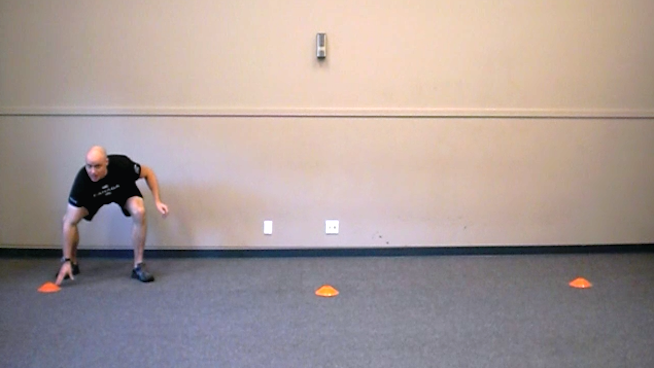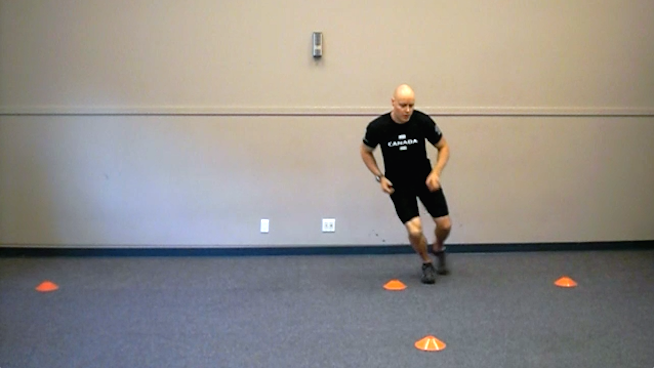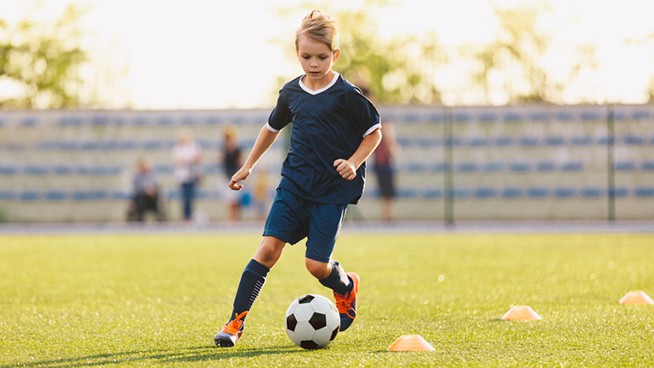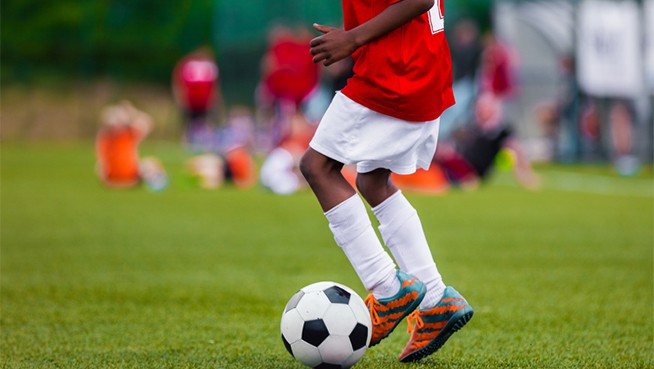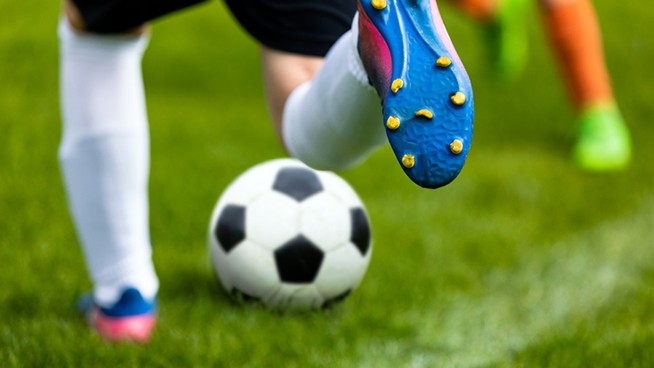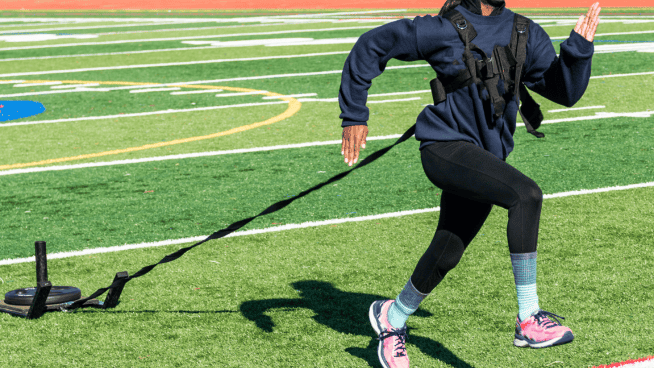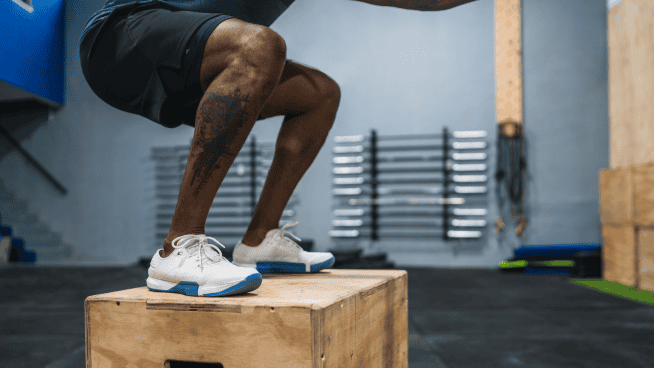Get Quick with these Agility Drills for Soccer
Want to dominate on the soccer pitch? Next to your skills, your speed and quickness are the real game changers. If you want to take your quickness to the next level, here is a blueprint of what you need to do and some specific agility drills to get you there.
Learn to run for speed, not efficiency
In soccer, you cover a lot of ground during a 90-minute game. Good soccer players learn to run efficiently to conserve energy. This involves taking moderate-length strides, keeping their knees low, using more of a mid-foot plant and having minimal arm pumping. This style of running makes you slow, yet it is the only one many soccer players learn.
RELATED: Increase Your Soccer Speed With 4 Sprint Drills
Soccer is filled with max sprinting. To improve your quickness, you need to practice running for speed. To run fast, you need to get your knees up higher, strike the ground more on the balls of your feet, explosively push off (with full extension of your hip) and aggressively pump your arms. You need to practice this outside of soccer.
Focus on a fast body, not fast feet
I’ve worked with a lot of soccer players over the years, and the overwhelming trend I notice is that most of them have fast feet. Just playing and practicing the sport is the best way to build soccer-specific fast feet.
What most soccer players lack is a fast body. To be a great soccer player, you want fast feet for ball handling and a fast body to get from point A to point B quicker than your opponent. To do this, continue to build fast feet with ball handling drills. During your off-field training, build a quicker body.
Whenever I do speed and agility testing with my soccer players, I see athletes who look fast and others who are fast. Some athletes have blinding foot speed that makes them look really fast. However, their electronic sprint times are not impressive. Other athletes look slow, but are much faster at moving their bodies, because they have learned to take fewer steps by covering more ground with each stride.
RELATED: Improve Soccer Agility with Lateral Strength Exercises
Starting and stopping your body requires tremendous amounts of relative strength and explosive power. A recent study in the Journal of Australian Strength & Conditioning found a connection between strength and an athlete’s ability to change direction. Even athletes who are naturally fast at longer-distance sprints struggle with starting, stopping and cutting.
Put in some quality time in the weight room to progressively get stronger, by performing Squats, Deadlifts and Olympic lift variations. If you put in the work, you will make some huge gains in your speed and agility.
Use the right training variables
There is no question that soccer requires impressive levels of conditioning. However, when many soccer players do their speed and agility work, they are really just doing conditioning. For example, it is not uncommon to see soccer players run through a speed or agility drill, jog back and repeat. It looks like speed work, but it’s really just fancy cardio.
RELATED: 4 Soccer Agility Drills to Improve Quickness and Dribbling
To build dominating speed and agility, you need to follow these four rules:
- No fatigue. Train speed at the start of soccer practice, or ideally at another time.
- Less than 10 seconds. Each speed or agility drill should last less than 10 seconds. After this, you start switching motor unit recruitment and energy systems away from the ones that build speed.
- Full recovery. After each drill, rest longer than you think you need to. The goal is to have full recovery so each set of the drill is just as fast and explosive as the previous one.
- Stop when your speed slows down. When you start to feel you are getting slower, stop practicing the drill. Remember, the goal is not to get tired, the goal is to get better—less is more!
Move from planned to unplanned agility drills
I like to start my athletes with planned drills. These allow them to practice the movement and learn how to position their bodies and do the drills with fewer strides. Then, once your mechanics are sound, include some unplanned drills, where you have to react to a random stimulus. This will more closely resemble what you do in soccer.
Here are five agility drills to get you quick for soccer!
1. 5-10-5 Agility
This is a fantastic drill to build power and strength for lateral stopping and starting. Practice staying low and learn to take fewer strides. This drill is traditionally done with the cones placed 5 yards apart, but you can vary the distance.
2. 5-10-5 Forward/Back Agility
This is a spin-off of the traditional 5-10-5 drill. It involves forward and backwards movement. We started using this at the request of one of our coaches to train the forward and back directional changes used in attacking and recovering.
3. Arrowhead Agility Drill
The arrowhead comes from the Nike SPARQ tests. It is great for testing and training soccer agility. The drill combines straight ahead sprinting with intense cutting. Be sure to do both sides so you are equally good in both directions. The standard testing distances are 10 meters from the start to the middle cone. The other two cones are 5 meters from the middle. Again, you can vary these distances.
4. Partner Lateral Cut Drill
In this drill, you run straight at your partner, who randomly passes the ball left or right. React, cut and sprint after the ball. Keep your distances short and spend equal time cutting in each direction.
5. Partner Multi-Directional Cut Drill
In this drill, you simply follow the visual cues of your coach’s or teammate’s foot and move in the direction indicated. Don’t get carried away this drill; it should last no more than 10 seconds.
[cf]skyword_tracking_tag[/cf]RECOMMENDED FOR YOU
MOST POPULAR
Get Quick with these Agility Drills for Soccer
Want to dominate on the soccer pitch? Next to your skills, your speed and quickness are the real game changers. If you want to take your quickness to the next level, here is a blueprint of what you need to do and some specific agility drills to get you there.
Learn to run for speed, not efficiency
In soccer, you cover a lot of ground during a 90-minute game. Good soccer players learn to run efficiently to conserve energy. This involves taking moderate-length strides, keeping their knees low, using more of a mid-foot plant and having minimal arm pumping. This style of running makes you slow, yet it is the only one many soccer players learn.
RELATED: Increase Your Soccer Speed With 4 Sprint Drills
Soccer is filled with max sprinting. To improve your quickness, you need to practice running for speed. To run fast, you need to get your knees up higher, strike the ground more on the balls of your feet, explosively push off (with full extension of your hip) and aggressively pump your arms. You need to practice this outside of soccer.
Focus on a fast body, not fast feet
I’ve worked with a lot of soccer players over the years, and the overwhelming trend I notice is that most of them have fast feet. Just playing and practicing the sport is the best way to build soccer-specific fast feet.
What most soccer players lack is a fast body. To be a great soccer player, you want fast feet for ball handling and a fast body to get from point A to point B quicker than your opponent. To do this, continue to build fast feet with ball handling drills. During your off-field training, build a quicker body.
Whenever I do speed and agility testing with my soccer players, I see athletes who look fast and others who are fast. Some athletes have blinding foot speed that makes them look really fast. However, their electronic sprint times are not impressive. Other athletes look slow, but are much faster at moving their bodies, because they have learned to take fewer steps by covering more ground with each stride.
RELATED: Improve Soccer Agility with Lateral Strength Exercises
Starting and stopping your body requires tremendous amounts of relative strength and explosive power. A recent study in the Journal of Australian Strength & Conditioning found a connection between strength and an athlete’s ability to change direction. Even athletes who are naturally fast at longer-distance sprints struggle with starting, stopping and cutting.
Put in some quality time in the weight room to progressively get stronger, by performing Squats, Deadlifts and Olympic lift variations. If you put in the work, you will make some huge gains in your speed and agility.
Use the right training variables
There is no question that soccer requires impressive levels of conditioning. However, when many soccer players do their speed and agility work, they are really just doing conditioning. For example, it is not uncommon to see soccer players run through a speed or agility drill, jog back and repeat. It looks like speed work, but it’s really just fancy cardio.
RELATED: 4 Soccer Agility Drills to Improve Quickness and Dribbling
To build dominating speed and agility, you need to follow these four rules:
- No fatigue. Train speed at the start of soccer practice, or ideally at another time.
- Less than 10 seconds. Each speed or agility drill should last less than 10 seconds. After this, you start switching motor unit recruitment and energy systems away from the ones that build speed.
- Full recovery. After each drill, rest longer than you think you need to. The goal is to have full recovery so each set of the drill is just as fast and explosive as the previous one.
- Stop when your speed slows down. When you start to feel you are getting slower, stop practicing the drill. Remember, the goal is not to get tired, the goal is to get better—less is more!
Move from planned to unplanned agility drills
I like to start my athletes with planned drills. These allow them to practice the movement and learn how to position their bodies and do the drills with fewer strides. Then, once your mechanics are sound, include some unplanned drills, where you have to react to a random stimulus. This will more closely resemble what you do in soccer.
Here are five agility drills to get you quick for soccer!
1. 5-10-5 Agility
This is a fantastic drill to build power and strength for lateral stopping and starting. Practice staying low and learn to take fewer strides. This drill is traditionally done with the cones placed 5 yards apart, but you can vary the distance.
2. 5-10-5 Forward/Back Agility
This is a spin-off of the traditional 5-10-5 drill. It involves forward and backwards movement. We started using this at the request of one of our coaches to train the forward and back directional changes used in attacking and recovering.
3. Arrowhead Agility Drill
The arrowhead comes from the Nike SPARQ tests. It is great for testing and training soccer agility. The drill combines straight ahead sprinting with intense cutting. Be sure to do both sides so you are equally good in both directions. The standard testing distances are 10 meters from the start to the middle cone. The other two cones are 5 meters from the middle. Again, you can vary these distances.
4. Partner Lateral Cut Drill
In this drill, you run straight at your partner, who randomly passes the ball left or right. React, cut and sprint after the ball. Keep your distances short and spend equal time cutting in each direction.
5. Partner Multi-Directional Cut Drill
In this drill, you simply follow the visual cues of your coach’s or teammate’s foot and move in the direction indicated. Don’t get carried away this drill; it should last no more than 10 seconds.
[cf]skyword_tracking_tag[/cf]
